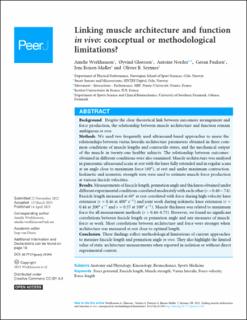| dc.contributor.author | Werkhausen, Amelie | |
| dc.contributor.author | Gløersen, Øyvind | |
| dc.contributor.author | Nordez, Antoine | |
| dc.contributor.author | Paulsen, Gøran | |
| dc.contributor.author | Bojsen-Møller, Jens | |
| dc.contributor.author | Seynnes, Olivier Roger | |
| dc.date.accessioned | 2023-10-23T12:10:08Z | |
| dc.date.available | 2023-10-23T12:10:08Z | |
| dc.date.created | 2023-04-14T10:28:20Z | |
| dc.date.issued | 2023 | |
| dc.identifier.citation | PeerJ. 2023, 11(2023), Artikkel e15194. | en_US |
| dc.identifier.issn | 2167-8359 | |
| dc.identifier.uri | https://hdl.handle.net/11250/3098097 | |
| dc.description | This is an open access article distributed under the terms of the Creative Commons Attribution License, which permits unrestricted use, distribution, reproduction and adaptation in any medium and for any purpose provided that it is properly attributed. For attribution, the original author(s), title, publication source (PeerJ) and either DOI or URL of the article must be cited. | en_US |
| dc.description.abstract | Background: Despite the clear theoretical link between sarcomere arrangement and force production, the relationship between muscle architecture and function remain ambiguous in vivo.
Methods: We used two frequently used ultrasound-based approaches to assess the relationships between vastus lateralis architecture parameters obtained in three common conditions of muscle lengths and contractile states, and the mechanical output of the muscle in twenty-one healthy subjects. The relationship between outcomes obtained in different conditions were also examined. Muscle architecture was analysed in panoramic ultrasound scans at rest with the knee fully extended and in regular scans at an angle close to maximum force (60°), at rest and under maximum contraction. Isokinetic and isometric strength tests were used to estimate muscle force production at various fascicle velocities.
Results: Measurements of fascicle length, pennation angle and thickness obtained under different experimental conditions correlated moderately with each other (r = 0.40−.74). Fascicle length measured at 60° at rest correlated with force during high-velocity knee extension (r = 0.46 at 400° s−1) and joint work during isokinetic knee extension (r = 0.44 at 200° s−1 and r = 0.57 at 100° s−1). Muscle thickness was related to maximum force for all measurement methods (r = 0.44–0.73). However, we found no significant correlations between fascicle length or pennation angle and any measures of muscle force or work. Most correlations between architecture and force were stronger when architecture was measured at rest close to optimal length.
Conclusion: These findings reflect methodological limitations of current approaches to measure fascicle length and pennation angle in vivo. They also highlight the limited value of static architecture measurements when reported in isolation or without direct experimental context. | en_US |
| dc.language.iso | eng | en_US |
| dc.subject | fascicle length | en_US |
| dc.subject | force potential | en_US |
| dc.subject | force-length | en_US |
| dc.subject | force-velocity | en_US |
| dc.subject | muscle strength | en_US |
| dc.subject | vastus lateralis | en_US |
| dc.title | Linking muscle architecture and function in vivo: Conceptual or methodological limitations? | en_US |
| dc.type | Peer reviewed | en_US |
| dc.type | Journal article | en_US |
| dc.description.version | publishedVersion | en_US |
| dc.rights.holder | © 2023 Werkhausen et al. | en_US |
| dc.source.pagenumber | 21 | en_US |
| dc.source.volume | 11 | en_US |
| dc.source.journal | PeerJ | en_US |
| dc.identifier.doi | 10.7717/peerj.15194 | |
| dc.identifier.cristin | 2140818 | |
| dc.description.localcode | Institutt for fysisk prestasjonsevne / Department of Physical Performance | en_US |
| dc.source.articlenumber | e15194 | en_US |
| cristin.ispublished | true | |
| cristin.fulltext | original | |
| cristin.qualitycode | 1 | |
